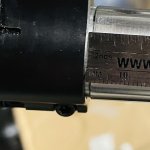I have begun working up loads for hogs with my AR15 6.5 Grendel build. The problem I have been having is after I fire a round, the case fails to eject. I have an adj. gas block which is basically wide open at this point. Barrel is a 22" with a rifle length gas system. I began working up reloads using 26grs of Alliant Power Pro Varmint using 123gr Hornady SST's. My heaviest charge is 28grs. For each 5 shot string, I inspected each case for signs of hi pressure. (Saw no indications with excessive pressure).
The issue I have is not 1 single case was ejected after the shot. In many cases, I had to really pull hard on the charge handle in order open the chamber and remove the spent brass. I finally had a friend watch the BCG while I took a shot down range to see if the BCG was moving at all. He said after watching me take 8 or so shots, the BCG did not move at all or moved back very little. (My guess is it may be related to head space issues...)
I have built 15+ AR's mostly .223 with 1 rifle chambered for for .204 Ruger, and 2 AR10's (1 chambered in .308 and the other, 6.5 Creedmoor) and everyone of them ran flawlessly.
Any ideas on a course of action to figure this out?
The issue I have is not 1 single case was ejected after the shot. In many cases, I had to really pull hard on the charge handle in order open the chamber and remove the spent brass. I finally had a friend watch the BCG while I took a shot down range to see if the BCG was moving at all. He said after watching me take 8 or so shots, the BCG did not move at all or moved back very little. (My guess is it may be related to head space issues...)
I have built 15+ AR's mostly .223 with 1 rifle chambered for for .204 Ruger, and 2 AR10's (1 chambered in .308 and the other, 6.5 Creedmoor) and everyone of them ran flawlessly.
Any ideas on a course of action to figure this out?



